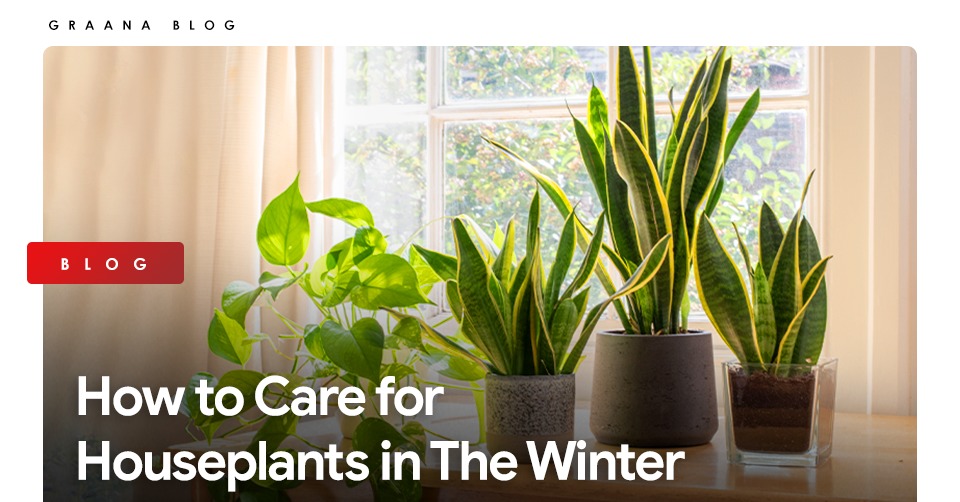Since most outdoor plants aren’t doing much in the winter, it’s known as the “quiet season” in the garden. Indoor gardens experience the same thing. There’s no need to worry about the chilly winds whipping through the landscape when you have houseplants. However, subtle changes occur inside your home during the colder, darker months of the year. To keep your houseplants healthy and flourishing in winter, you’ll need to adapt your care routine. The following tips will ensure that your green friends will keep filling your home with their lushness and natural beauty throughout the winter.
Nevertheless, even indoor winter houseplants are aware of the seasons, even if they remain in pots. Houseplants are just as tolerant of winter as their outdoor counterparts. Although their colors remain vibrant indoors, they are essentially dormant.
In preparation for winter, houseplants need to make simple but significant changes to their care. Winter is when plants rest for the year ahead. As part of plant preparation, it is essential to protect them from extremes of temperature, dry air, and low light levels. Find out how to protect your plants for winter now.
Repotting Houseplants in Winter
Repotting houseplants during the winter is a good idea. Repotting is not needed or beneficial for all plants. To determine whether your plant needs new living quarters, you can look for a few different signs.
Roots need more room to grow, so repotting is a necessity. A physically too large plant for its pot is one of the most obvious signs. Overgrown plants in plastic pots tend to topple over as the soil dries out. There is a possibility that roots will grow into the drainage holes in the bottom of the pot. Based on these symptoms, you probably needed to repot your plant several months ago.
You can quickly check the soil ball by turning the pot over, gently pulling the plant from the pot, and checking the roots. The plant would likely benefit from a larger container if many roots are visible outside the soil ball. No repotting is necessary if no roots can be seen.
Choose a pot only slightly larger than the previous one. Root rot can occur when too much moisture is retained in the soil in too large pots. Make sure you leave enough space at the top of the pot when filling it with soil for watering.
If given a larger container, some plants would grow even larger because they are already too large for the existing environment. The only repotting needed in this case is replanting in the same pot in fresh soil.
Sunlight is Important
During the winter, plants receive less sunlight because the sun rises later and sets earlier. Your plants may benefit from more light if you can move them closer to the window. Make sure your plants get sunlight on all sides by rotating their pots a quarter turn every week. Most plants will do just fine if you don’t boost the light levels. As the seasons change outdoors, your indoor plants will adjust accordingly.
Dropped Leaves are Nothing to Worry About
Bringing houseplants back indoors after spending the summer outdoors will likely result in them dropping leaves. This is entirely normal because they have adapted to a lower light level indoors. You should expect a small amount of leaf drop as your plants enter winter if kept indoors year-round. It is normal for houseplants to shed leaves due to winter as they prepare for lower light levels.
Fertilizing Indoor Plants in Winter
For healthy and bushy growth, you need to fertilize your indoor plants. What about the fall and winter dormant seasons? Should you fertilize your indoor plants during this time? Will fertilizing our plants during dormancy have any positive effects, or will it harm them instead? Read on and find out!
Fertilizing houseplants in winter is not recommended since most of them grow during the spring and summer and remain dormant during the winter. Plants’ health can be negatively impacted if they are fertilized during winter. Fertilizing indoor plants only need to be done during spring and summer.
The importance of fertilization cannot be overstated. Plants can suffer from numerous problems if they are over-fertilized or fertilized at the wrong time of the year.
The natural environment for outdoor plants includes several processes: leaves and branches dropping, microorganisms eating the organic matter, and earthworms creating nutrients to fertilize the soil.
Potting soil mixes for indoor houseplants do not contain all that microbial activity. For this reason, we provide nutrients to feed the plant.
There are different types of fertilizers for every soil type and what the plant needs. Using organic and synthetic fertilizers in combination can create a balance in the soil.
Best Winter Indoor Plants
Following are the best indoor plants for cold winter:
1. Aloe Vera
Known as a common houseplant and a folk remedy for itching and burning, this large succulent grows up to four feet tall. During the winter, aloes flower profusely if they receive sufficient light throughout the year. For them, good drainage and bright light are essential.
2. Moth Orchid
There are no shortages of these orchids sold year-round since they are probably the most recognizable. You can expect them to bloom with average soil moisture and filtered light for many months.
3. Corn Plant
It is easy to care for corn plants. The leaves might get scorched if exposed to drafts and direct sun. Overwatered plants have droopy yellow leaves. Ensure that the pot has a drain hole so that the plant never stands in water.
4. Snake Plant
Snake plants can be grown if all else fails. It needs a lot of light, prefers partial shade, and does not require much watering. An excellent beginner plant! The Snake Plant may be a good choice for those looking for hardy winter plants while also adding some architectural interest to their home. Low light or drought does not affect the Snake Plant during the winter months.
The colors and patterns of the plant’s blade-shaped leaves are stunning. Besides purifying the air, the plant has many other health benefits.
This one’s definitely your best indoor plant for cold weather!
5. Cactus
This one was bound to make its name under the winter house plants list, wasn’t it? Cacti rarely require watering because they can store water and nutrients. The plant loves the sun and looks great when grouped under a window.
Indoor plants that can withstand heat and cold
1. ZZ Plant
An iconic houseplant best known for its bright, green foliage, the ZZ Plant is also known as the Arum Fern. However, its defining characteristic is the ability to withstand any amount of winter cold.
2. Jade
The Jade Plant is an excellent houseplant that can withstand winter cold due to its dense foliage and woody stems. You can keep it anywhere since it can handle hot and cold wind. Plants age gracefully and eventually transform into miniature trees as they age.
Houseplants in Winter: What are The Most Common Mistakes?
Houseplants are killed or weakened by overwatering in winter. Weak plants are also more susceptible to scales, mealy bugs, and whiteflies.
When any of these pests are present, wipe them off with a damp cloth and pick up dead or dying leaves. The end of the summer can also be a good time to feed the plant with diluted seaweed extract.
You should also avoid allowing sudden temperature changes to affect your houseplants during winter. Plants should be kept away from the main sources of heat as the heating ramps up. Avoid placing house plants in winter in drafty areas as well.




